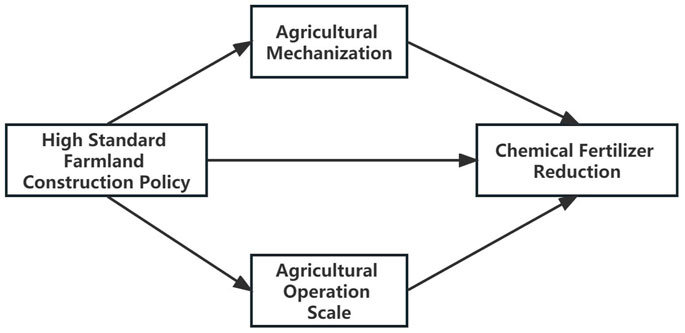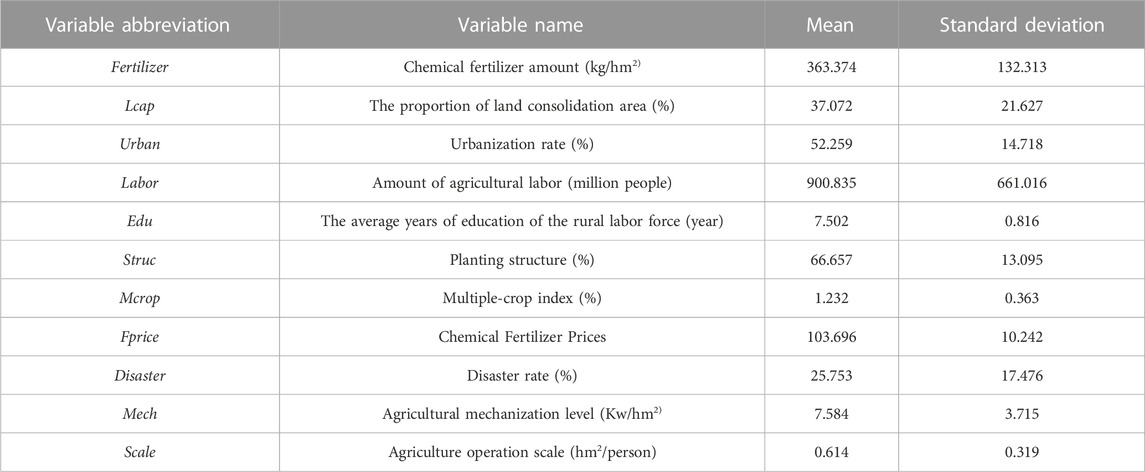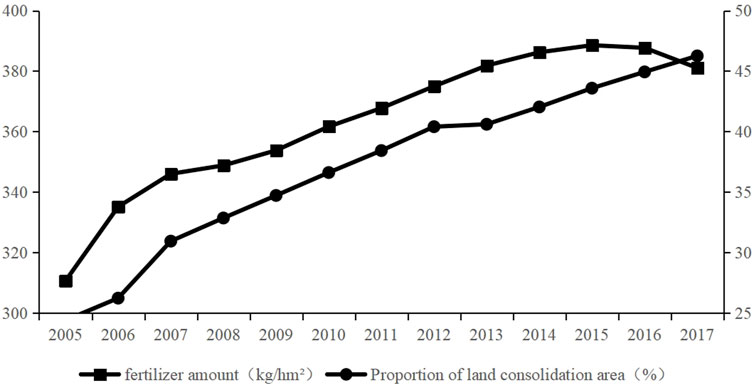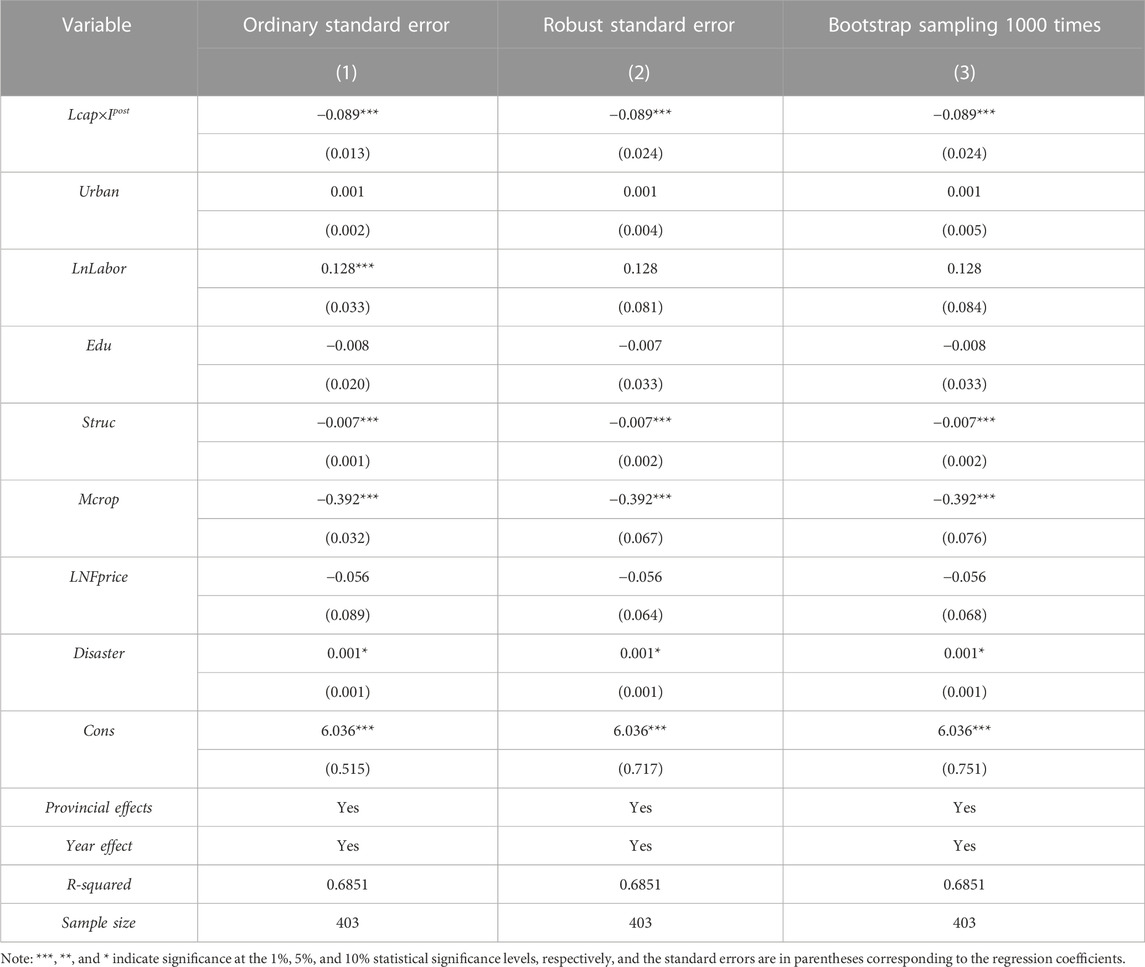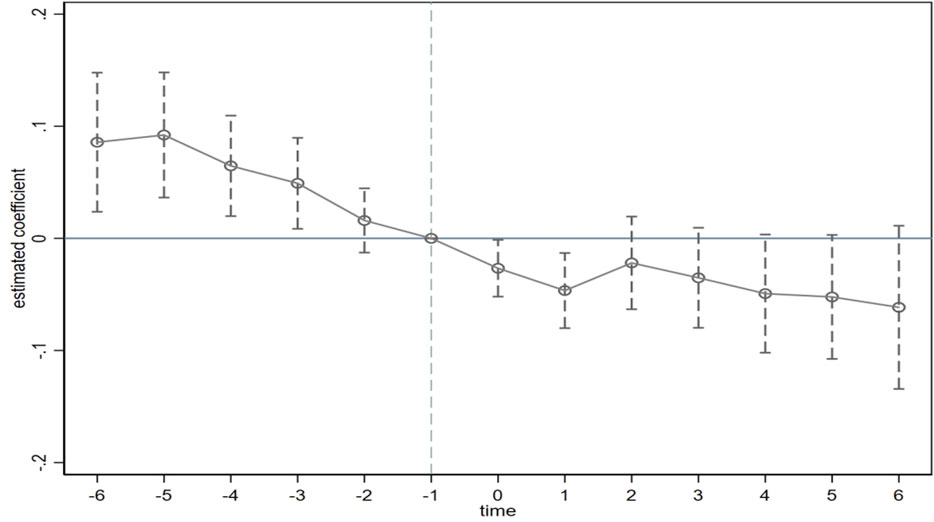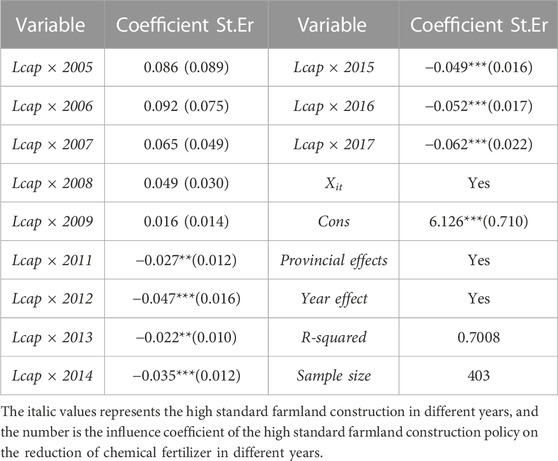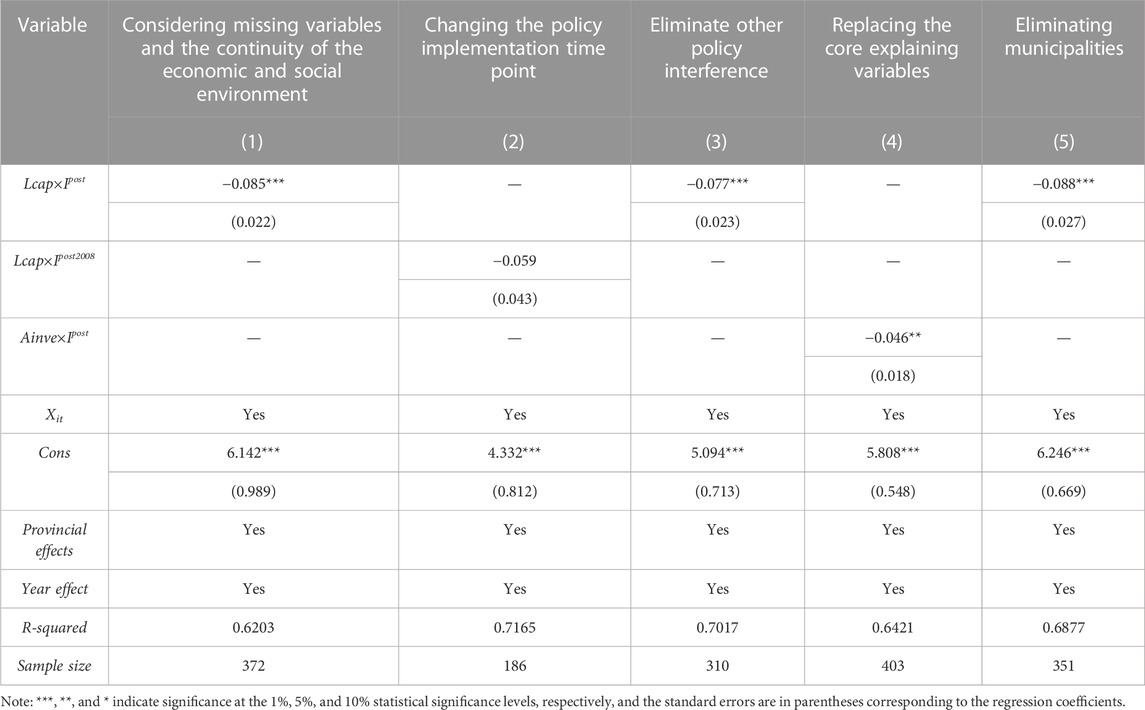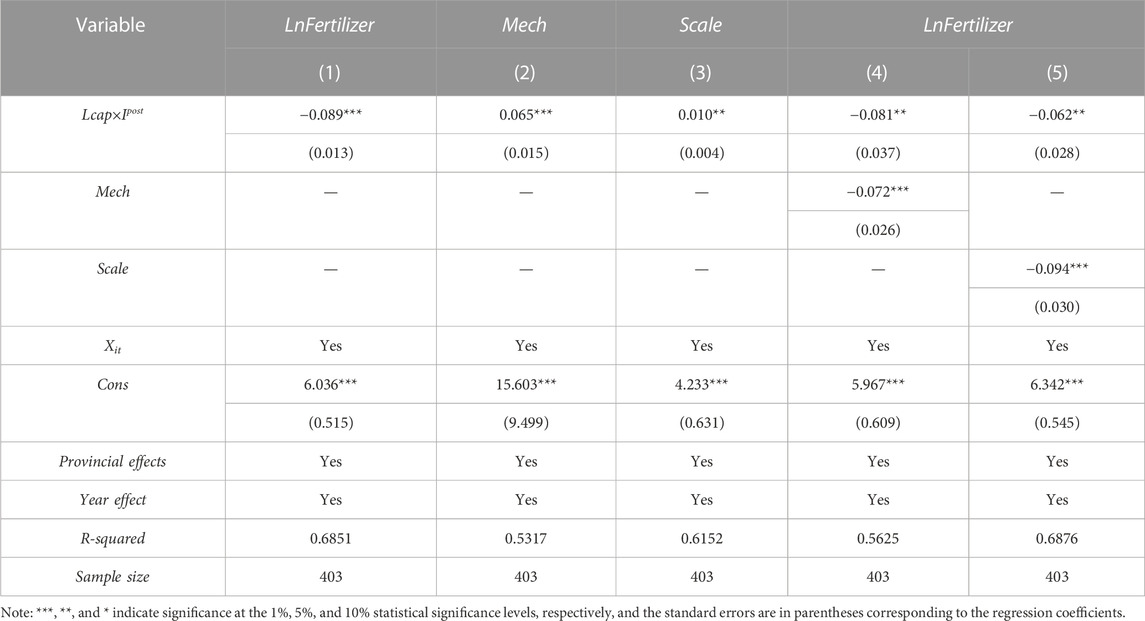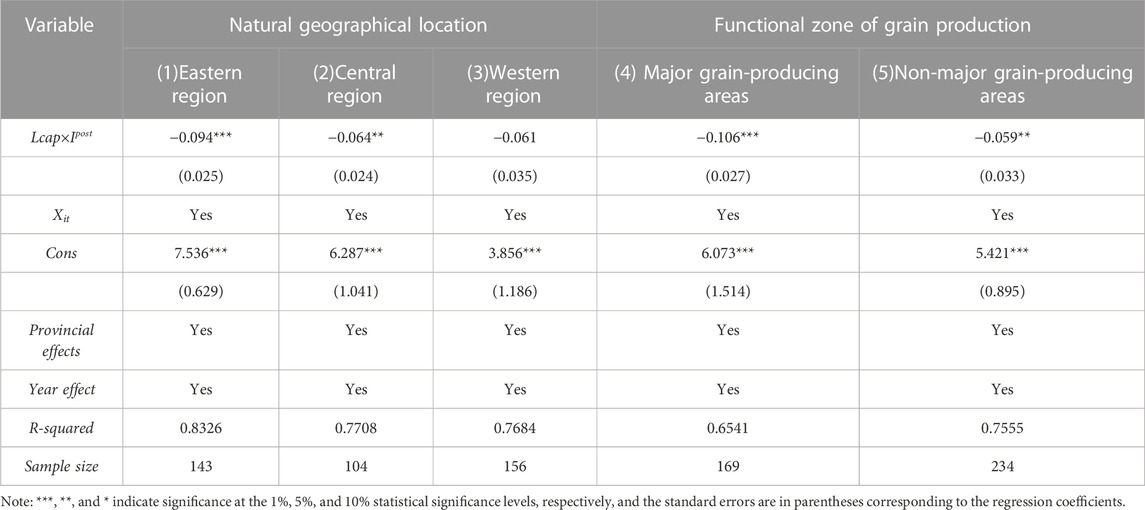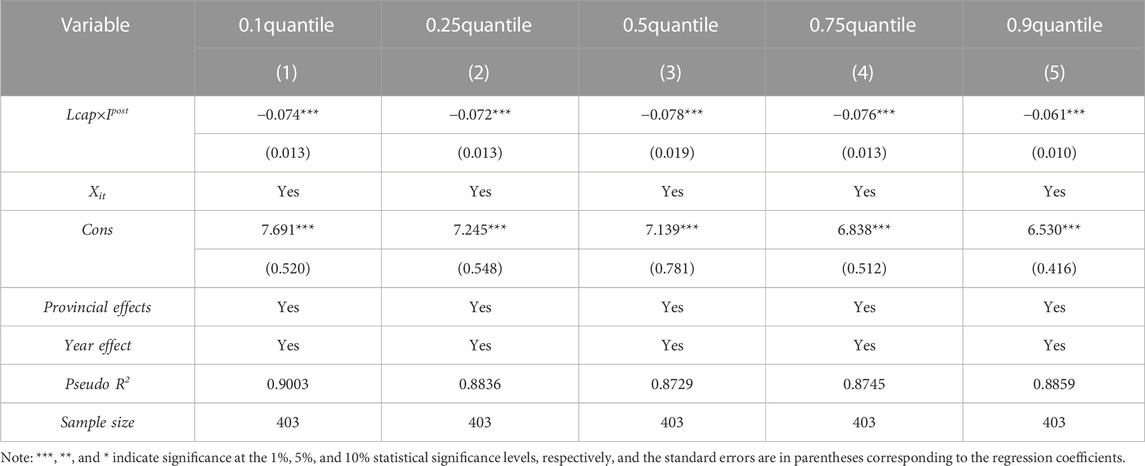- 1School of Economics and Management, Jiangxi Agricultural University, Nanchang, China
- 2Jiangxi Rural Revitalization Strategy Research Institute, Nanchang, China
Promoting chemical fertilizer (CF) reduction is an inevitable requirement for achieving high-quality agricultural development, and high standard farmland construction (HSFC) provides a new path for promoting CF reduction. Takes the implementation of HSFC policy as the starting point, this paper uses the provincial panel data of China from 2005 to 2017 to analyze the impact of HSFC policy on CF reduction and its mechanism of action by using the continuous difference-in-difference (DID) model and mediating model. The baseline regression results show that implementing the HSFC policy has reduced the amount of CF per unit area by 8.9 % on average, which has a significant policy effect. The mechanism analysis shows that the HSFC policy can promote CF reduction by improving the agricultural mechanization level and expanding the scale of operations in agriculture. The results of heterogeneity analysis show that in the natural geographical location dimension, the effect of HSFC policy on CF reduction in the eastern and central regions is more obvious; In the dimension of functional areas of grain production, the impact of HSFC policy on CF reduction in major grain-producing regions is more obvious. Therefore, in the future, it is necessary to continue to vigorously promote the HSFC and give full play to the effective role of HSFC in CF reduction. China should vigorously promote the development level of agricultural mechanization and the large-scale operation of agriculture and further strengthen the HSFC in the western region and non-major grain-producing areas.
1 Introduction
Since the reform and opening up, chemical fertilizer (CF) application has become increasingly common in agricultural production to improve soil fertility and has played an essential role in enhancing China’s agricultural production efficiency and increasing crop yield (Lin J Y, 1992). For an extended period, to pursue high work and high efficiency, people have continuously improved the input of CF (Liu et al., 2020). According to the China Bureau of Statistics, the amount of CF applied in China increased from 58.892 kg/hm2 to 307.730 kg/hm2 from 1978 to 2021. However, we also clearly recognize that based on the law of diminishing returns to scale, excessive CF application is difficult to achieve sustained agricultural growth (Krugman, 1994). Applying large amounts of CF in agricultural production will lead to problems such as soil hardening and degradation, water environment pollution, and higher production costs (Kumar R et al., 2019). For example, over-fertilization in China causes more than 10 million tons of nitrogen to be lost off farmland yearly, resulting in direct economic losses of about 30 billion yuan. Excessive CF will also infiltrate shallow groundwater within 20 m, increasing the nitrate content in groundwater, which is not conducive to ensuring China’s food security and sustainable agricultural development. To improve soil fertility, increase grain production and stabilize grain production, in September 2011, the former Ministry of Land and Resources of China issued the “High Standard Basic Farmland Construction Specification (Trial)” for the first time, marking that China’s high standard farmland construction (HSFC) policy has entered the pilot implementation stage. China’s former Ministry of Agriculture promulgated the “high standard farmland construction standard” on 1 March 2012, to strictly protect cultivated land quality. In 2013, the State Council approved the “China Agricultural Comprehensive Development High Standard Farmland Construction Plan (2011–2020)” for the first time to cover HSFC measures in five aspects: water conservancy, agriculture, field road construction, forestry, and science and technology. The critical content involves farmland engineering, soil improvement, agricultural mechanization, stock breeding, and promotion of improved varieties. Since then, the importance of HSFC has been emphasized in China’s Central No. 1 Document every year. By 2021, China’s HSFC area has reached 910 million mu. The data showed that the mechanization level of high-standard farmland projects is 15–20 percentage points higher than that of non-project regions, and the water saving reaches 20%–30%. Can high-standard farmland projects reduce CF, agricultural production costs, and agricultural output efficiency? It is a topic worthy of further discussion.
Recently, China has implemented several CF reduction measures. Although the problem of excessive CF application has been alleviated, it has not been fundamentally solved (Huang J et al., 2017). Many scholars have tried to explore a fast and effective Chinese path to promote CF reduction from multiple perspectives, mainly including the following aspects. Firstly, from the standpoint of production technology, it focuses on the impact of CF or soil production factors, such as the scientific application of CF (Ju X et al., 2009), the use of biological fertilizers (Wang X Y et al., 2021), efficient rotation and intercropping (Han J et al., 2021), soil improvement (Abbruzzini T F et al., 2019), etc. Secondly, from the perspective of the main body of agricultural management, it focuses on the influence of farmers or rural households “factors, such as farmers” income level (Li D et al., 2012), cognitive characteristics (Li Y F et al., 2019), risk preference (Li X and Shang J., 2021), etc. Thirdly, from the perspective of agricultural management, focusing on the confirmation of land right (Holden and Yohannes, 2002), land tenure security (Li B and Zeng Q., 2022), scale management (Wu X. et al., 2021), agricultural specialization (Zhou S et al., 2023), agricultural mechanization level (Liu J et al., 2022); Fourthly, from the consumer side, focusing on guiding consumers to enhance their preferences for green or organic agricultural products, and forcing agricultural production to transition to CF reduction (Tian M et al., 2022). It can be seen that the research on the factors affecting the promotion of CF reduction is diversified, but the effect of HSFC policies is ignored. As the basis of farmland behavior, the cognition of HSFC policy is the critical step to promote the development of modern agriculture.
There are discussions on HSFC policies, mainly focusing on the planning and design of construction (Song W et al., 2019), suitability analysis of construction implementation (Wang Y et al., 2022), construction potential assessment (Pu L et al., 2019), status analysis of construction implementation (Ye F et al., 2023), and supervision of high standard farmland (Peng et al., 2022a). There are few studies on the performance evaluation of the policy, mainly focusing on evaluating the guarantee capacity of food security (Yan H et al., 2022). The environmental effects of the policy have not been fully discussed, such as the effect of CF reduction.
This paper uses the panel data of 31 provinces, municipalities, and autonomous regions in China from 2005 to 2017, uses the continuous difference-in-difference model to analyze the impact of HSFC on CF reduction empirically, and further analyzes and verifies its impact mechanism to provide scientific and reasonable policy reference for promoting CF reduction based on HSFC in the future. Compared with the existing literature, the main contributions of this paper are as follows: firstly, theoretical analysis of the influence logic of HSFC policy on CF application, deepen the understanding of the environmental effects of HSFC policy, and provide new ideas for promoting sustainable agriculture development in China; secondly, the continuous difference-in-differences method was used to explore the effect of HSFC policy on the amount of CF application and its heterogeneity, eliminate the confusing effects of unobservable factors that do not change with time, and improve the accuracy of the research conclusions; Thirdly, take the introduction of agricultural machinery and operation scale as mediating variables to reveal the internal mechanism and realization path of the reduction effect of HSFC policies on the total amount of CF application, so as to provide scientific and reasonable policy reference for promoting CF reduction based on HSFC in the future.
The rest of the paper proceeds as follows. The second section combs the theoretical logic of HSFC policy and CF reduction. The third section is the research design, including empirical models, variable selection, data sources, etc. The fourth section analyzes the impact of the policy on the amount of CF and its mechanism of action. The fifth section summarizes the research results and discusses policy recommendations.
2 Theoretical analysis and research hypothesis
2.1 Effect of HSFC policy on CF reduction
High-standard farmland refers to the bare farmland formed by rural land consolidation in a certain period, which is concentrated, equipped with facilities, high and stable yield, sound ecology, strong disaster resistance, and suitable for modern agricultural production and management. The implementation of HSFC policies has had an important impact on promoting CF reduction. Firstly, improving cultivated land quality is urgently needed to achieve CF reduction (Wu H. et al., 2021). The HSFC policy increases the organic matter content of the soil. It improves the quality and output capacity of cultivated land by establishing the monitoring point of cultivated land quality, tracking and monitoring the quality of cultivated land, and taking measures such as applying organic fertilizer in time. Farmers’ dependence on CF is reduced when cultivated land quality is improved. Secondly, through the transformation of field roads, the HSFC policy determines the width and density of roads according to the topographic conditions of various places, improves the degree of specialization of agricultural production and the organic composition of capital in the agricultural sector, and provides the possibility for the use of agricultural social services to promote CF reduction (Yang, C et al., 2022). Finally, HSFC helps reduce the cost of farmers’ use of CF by realizing land leveling and centralized contiguous management and reducing cultivated land fragmentation (Hu et al., 2022). Therefore, on the whole, HSFC policies can promote CF reduction. Based on the above analysis, the research hypothesis is proposed:
Hypothesis 1:. HSFC policies will promote CF reduction.
2.2 HSFC policy, agricultural mechanization, and CF reduction
The CF reduction depends not only on the progress of agricultural technology but also on the adoption of reduction technology by micro-business entities. The classical economic growth theory holds that farmers are an economic entity that passively adopts new technologies (Hu Y and Zhang Z H, 2018). For example, mechanical fertilization achieves CF reduction by uniforming operation quality and saving labor costs, but agricultural machinery’s high investment cost limits farmers’ investment motivation (Sarkar A, 2020). However, under an open factor market, many agricultural households choose to outsource production links, and CF reduction also has internal motivation. Whether farmers directly purchase machinery or purchase productive services such as machinery, they need to meet the requirements of agricultural machinery for road patency, ground leveling, and concentration of working areas. The HSFC policy optimizes the working environment of agricultural machinery. It promotes CF reduction through field road construction, land consolidation, and “change the land to fit the machine” (Wan L X and Yang G, 2023). Based on the above analysis, the research hypothesis is proposed:
Hypothesis 2:. Improving the level of agricultural mechanization can promote CF reduction.
Hypothesis 3:. HSFC policies can promote CF reduction by increasing agricultural mechanization levels.
2.3 HSFC, agricultural operation scale, and CF reduction
CF reduction is also closely related to the agricultural operation scale. On the one hand, CF reduction has specific requirements on the operation scale (Chen X and Liu T, 2023). Large-scale operations will reduce the cost of CF application per unit area, which is conducive to farmers’ adoption of CF reduction (Guo J et al., 2022). For example, the promotion of soil testing and balanced fertilization technology has the disadvantages of difficulty, time-consuming and high cost, which makes the adoption of small-scale farmers relatively low (Wu H et al., 2022); On the other hand, the government has strict requirements on the use of CF by large-scale farmers. In addition, large-scale operations can facilitate government training and guidance on CF reduction (Wu Y et al., 2018). Therefore, within the appropriate scale, the expansion of the operation scale can promote CF reduction. HSFC policy will also have a certain impact on the operation scale. The HSFC can alleviate the fragmentation of farmland, promote the large-scale operation of farmland as a whole and improve the efficiency of agricultural technology (Bhatt and Bhat, 2014), release the scale economy effect, and further promote the development of moderate-scale operation. Based on the above analysis, the research hypothesis is proposed:
Hypothesis 4:. Expanding the agricultural operation scale can promote CF reduction.
Hypothesis 5:. HSFC policies can promote CF reduction by expanding the agricultural operation scale.
Based on the above theoretical analysis, the theoretical framework of this paper is shown in Figure 1.
3 Research design
3.1 Model design
The HSFC policy began to be standardized and implemented nationwide in 2011, which resulted in significant differences in the scale of land consolidation around 2011. At the same time, due to the spatial heterogeneity of policy implementation (Delgado and Florax, 2015), the HSFC policy can be used as a natural experiment to form a research space for policy effect evaluation. So this paper intends to use a continuous DID model to examine the effect of HSFC policies on CF reduction. The continuous DID can directly use continuous variables to distinguish the treatment group and the control group, which can capture more data variability and avoid the deviation caused by artificially setting the treatment group and the control group (Chen Y and Zhou L A, 2007). Specifically, this paper uses the continuous variable of “the proportion of land consolidation area” to distinguish the treatment group (samples with a large proportion of land consolidation area) and the control group (samples with a small proportion of land consolidation area).
3.1.1 Baseline regression model
To investigate the effect of HSFC policy on the amount of CF, referring to the practice of Fortson J G (2009), this paper constructs the following continuous DID model:
In Eq. 1, lnFertilizerit is the explained variable, which represents the amount of CF per unit area of province i in period t and takes the natural logarithm; Lcapi represents the continuous variable of the proportion of land consolidation area; Itpost represents the dummy variable of the time point of policy implementation. When the time is taken during the policy implementation period, take 1; otherwise, 0; Xit represents a series of control variables; μi is the provincial fixed effect, γt is the time fixed effect, and εit is the random error term. α is a constant term, β and δ are the parameters to be estimated.
3.1.2 Parallel trend test model
Referring to the practice of Nunn and Qian (2011), the following model is constructed to test the parallel trend hypothesis:
Dt represents the year dummy variable. The remaining variables and symbols have the same meaning as Eq. 1.
3.1.3 Mechanism verification model
In order to identify whether HSFC policies affect CF reduction by expanding the agricultural operation scale and improving the agricultural mechanization level, the following models were constructed by referring to the mediating effect analysis method proposed by Wen Z L and Ye B J (2014):
In Eqs 3, 4, Mit is the mechanism variable of concern: the agricultural mechanization level and the farm operation scale. θ, ω, and τ are the parameters to be estimated. The remaining variables are consistent with (1).
3.2 Variable selection
3.2.1 Explained variables
The amount of CF is characterized by the amount per unit area, calculated by dividing the total amount of CF application by the total sown area of crops.
3.2.2 Core explanatory variables
High standard farmland construction (HSFC) policy. The interaction term (Lcapi×Itpost) between the proportion of land consolidation area and the dummy variable of the HSFC policy implementation time point was used to characterize. The proportion of land consolidation area is the percentage of low-yield and high-standard farmland in the total cultivated land area. At the same time, the interaction term (Ainvei×Itpost) of agricultural comprehensive development investment and policy variables is used as a substitute variable for the core explanatory variable for the robustness test (Liang et al., 2021).
3.2.3 Control variables
In addition to the impact of HSFC policies on the amount of CF per unit area, it is also necessary to control the exogenous interference of other factors on the amount of fertilizer per unit area. Based on the practice of Xu et al. (2022) and Xiang et al. (2022), the following control variables are selected: Urbanization rate (Urban), the percentage of urban population in the total population; The number of agricultural labor force (Labor), expressed as the number of people employed in the primary industry; The average years of education (Edu) of rural labor force is calculated according to the weighted years of schooling at different learning stages; Planting structure (Struc) is expressed by the ratio of the sown area of grain crops to the total planted area of crops; The multiple cropping index (Mcrop) is described as the ratio of crop planting area to cultivated land area; The price of chemical fertilizer (Fprice) is characterized by the price index of chemical fertilizer production materials, with 2005 as the base period; The disaster rate (Disas) is the percentage of the affected area to the cultivated land area.
3.2.4 Mediating variable
According to the above theoretical analysis, the agricultural mechanization level (Mech) and the agricultural operation scale (Scale) are selected as the mechanism variables, and the ratio of agricultural machinery’s total power to the cultivated land area is used to measure the farm mechanization level. Referring to Peng et al. (2022b) research, this paper measures the scale of agricultural operation from the perspective of per labor crop planting area.
3.3 Data sources and descriptive evidence
This paper takes 31 provinces, municipalities, and autonomous regions from 2005 to 2017 (due to the serious lack of data in Hong Kong, Macao and Taiwan, it is eliminated) as the research object and analyzes the impact of HSFC policies on CF use. Among them, the amount of CF, the number of the agricultural labor force, and the average years of education of the rural labor force are derived from the China Rural Statistical Yearbook; the proportion of land consolidation area and the input data of agricultural comprehensive development are from the China Financial Yearbook; the urbanization rate, planting structure, multiple cropping index, CF price index, disaster rate, agricultural mechanization level, and agricultural operation scale data are derived from the China Statistical Yearbook. Table 1 shows the descriptive statistical characteristics of the variables.
It can be seen from Figure 2 that from 2005 to 2017, the proportion of land consolidation areas in China increased year by year, and it showed a rapid upward trend after the implementation of the HSFC policy. At the same time, after the performance of the HSFC policy, the growth trend of CF use per unit area slowed down. After reaching its peak in 2015, it began to show a declining trend. The factors affecting the amount of CF are very complicated. To more accurately study the relationship between HSFC policies and the amount of CF, relevant control variables need to be added. This paper conducts an empirical analysis of this.
4 Empirical results and analysis
4.1 Baseline regression results
Before the baseline regression, the variance inflation factor test found that the VIF values of each explanatory variable were lower than 4.21, so the multicollinearity problem between explanatory variables could be excluded. According to Formula 1, the effect of the implementation of the HSFC policy on the amount of CF per unit area is estimated. The results are shown in Table 2. Table 2 column (1)–(3) is the estimation results of the common standard errors, the robust standard errors, and the standard errors obtained by Bootstrap self-help random sampling for 1000 iterations. In the case of three standard misestimations, the estimated coefficients of the HSFC policy on the amount of CF per unit area have passed the 1% significance level test, indicating that the model estimation results have good robustness. At the same time, the coefficient of the HSFC policy variable is negative, meaning that the HSFC policy can significantly reduce the amount of CF per unit area. Under the same other conditions, the estimated coefficient of the HSFC policy is −0.089, which indicates that the implementation of the HSFC policy has reduced the amount of CF per unit area by 8.9% on average and has a significant policy effect. Accordingly, Hypothesis 1 is verified. In addition, considering that this paper focuses on the causal relationship between HSFC policy and CF use per unit area, there is little discussion on control variables.
4.2 Parallel trend test and dynamic impact of policy
The continuous DID model’s premise is that it needs to pass the parallel trend test. Although the previous graphic can preliminarily test the parallel trend, to more accurately judge whether the HSFC policy meets the parallel trend hypothesis before implementation, this paper tests it through the econometric model in Formula (2). Figure 3 depicts the changing trend of the estimated coefficient. It can be found that before the implementation of the HSFC policy, the estimated coefficient βt generally showed a downward trend, and the confidence interval of the impact coefficient included the value of 0. Therefore, it can be judged that there is no systematic difference in the estimated coefficients between the years before the implementation of the HSFC policy and the parallel trend test passed. At the same time, it shows that the HSFC proposed in 2011 can be regarded as a quasi-natural experiment and can be estimated using the continuous DID model.
Table 3 reports the dynamic estimation results of the impact of the implementation of HSFC policies on the amount of CF per unit area. From the first year before the implementation of the HSFC policy, the estimated coefficient has changed to a negative number. The reason is that the implementation of the HSFC policy can be pre-judged. In 2010, the Central No. 1 Document proposed vigorously building high-standard farmland, causing some provinces to respond in advance. It is not difficult to understand why the effect of HSFC policy on CF reduction can be observed in the first year before the implementation.
In addition, the estimated coefficients were not significant before the implementation of the HSFC policy. In contrast, the estimated coefficients passed the significance test and were negative in the year and after the policy implementation. Before the implementation of the HSFC policy, the estimated coefficient shows a general downward trend, indicating that the policy’s effect on CF reduction is continuous.
Specifically, the effect of the HSFC policy on CF reduction showed a positive trend of decreasing first and then increasing. The estimated coefficients in the current year and the first year of the implementation were −0.027 and −0.047, respectively, with a significant decrease. In the second year (2013) after the implementation of the HSFC policy, the estimated coefficient increased significantly (−0.022). Starting from 2013, the estimated coefficient of the HSFC policy showed a steady downward trend and reached the lowest value (−0.062) in the sixth year (2017) after the implementation. The estimated coefficient of the fifth year (2016) of the implementation of the HSFC policy (−0.052). Overall, this shows that the HSFC policy is sustainable.
4.3 Robustness tests
In order to ensure the robustness of the model estimation results, this paper draws on the research of Acemoglu et al. (2019), Zhang et al. (2019), and Zhu et al. (2020), trying to consider the missing variables and the continuity of the economic and social environment, change the policy implementation time point, eliminate other policy interference, replace core explanatory variables, and eliminate municipalities. The results are shown in Table 4.
4.3.1 Considering the missing variables and the continuity of the economic and social environment
By introducing per capita GDP into the control variables and lagging it with the CF price index for one period, the impact of missing variables and the continuity of the economic and social environment on the estimation results is controlled. The estimation results are shown in Column (1) of Table 4. The interaction term Lcap×Ipost still significantly negatively affects the amount of CF per unit area at 1%, and the previous baseline estimation results are still valid.
4.3.2 Changing the policy implementation time point
This paper selects the sample data before the policy implementation (i.e., 2005–2010) and takes 2008 as the time point of policy implementation for the placebo test. The estimated results are shown in Column (2) of Table 4. The results show that the estimated coefficient of the interaction term Lcap×Ipost2008 on the amount of CF per unit area is negative but insignificant. Therefore, it can be considered that other policies have no effect before implementing the HSFC policy. This again verifies the robustness of the previous baseline estimation results.
4.3.3 Eliminating other policy interference
In 2015, the Ministry of Agriculture (now the Ministry of Agriculture and Rural Affairs) issued the ‘Zero Growth Action Plan for Chemical Fertilizer Use by 2020′to guide the reduction of CF use in agricultural production in various regions, which will inevitably have an impact on the amount of CF used per unit area. Therefore, this paper verifies whether the baseline estimation results are robust by eliminating the data after 2015, and the estimation results are shown in Column (3) of Table 4. Considering the interference of the zero growth policy of CF, the HSFC policy still has a significant adverse effect on the amount of CF per unit area at the level of 1%.
4.3.4 Replacing core explanatory variables
The input of comprehensive agricultural development is also the main basis for measuring the degree of HSFC. If there is a causal relationship between the implementation of HSFC policies and the CF reduction, then whether it is the proportion of land consolidation area or the interaction of virtual variables between the input of comprehensive agricultural development and the time point of policy implementation will not change the basic conclusions of this paper. The results in Column (4) of Table 4 show that the negative impact of the interaction term Ainve×Ipost after replacing the core explanatory variables on the amount of CF per unit area is significant at the 5% level, and the estimated coefficient is −0.046. This again confirms the robustness of the pre-conclusion.
4.3.5 Elimination of samples from municipalities directly under the central government
Considering that the cities differ from the general provinces regarding administrative power, economic level, and agricultural development, this paper further narrows the sample range. It excludes the data from four samples Beijing, Tianjin, Shanghai, and Chongqing. Table 4 Column (5) is its estimation result. The estimated coefficient of the HSFC policy is still significantly negative at the statistical level of 1%. It is very close to the estimated value of the baseline model, indicating that the previous baseline regression results are still robust.
4.4 Mechanism analysis
The empirical results above show that the HSFC policies promote CF reduction. Based on the previous theoretical analysis, this part analyzes the specific mechanism of action from the perspectives of agricultural mechanization level and agricultural operation scale. Table 5 reports the results of the mechanism analysis.
The results of Column (2) in Table 5 show that the implementation of the HSFC policy has a significant positive impact on the agricultural mechanization level, with a coefficient of 0.065, which has passed the 1% significance level test. It shows that implementing the HSFC policy is conducive to improving the agricultural mechanization level. Compared with Column (4), it can be seen that when the mediating variable of agricultural mechanization level is added to the model, the significance of the estimated coefficient of the HSFC policy on the amount of CF per unit area has decreased, from the original significant at the 1% level to the significant at the 5% level. The estimation coefficient of the HSFC policy on the amount of CF per unit area has increased. The agricultural mechanization level has partially mediated the HSFC policy’s promotion of CF per unit area. This shows that the HSFC policies promote CF reduction by improving the agricultural mechanization level. In summary, the research Hypotheses 2 and Hypotheses 3 are verified.
The results of Column (3) in Table 5 show that the implementation of the HSFC policy has a significant positive impact on the agricultural operation scale, with a coefficient of 0.010, which has passed the 5% significance level test, indicating that the implementation of the HSFC policy is conducive to improving the agricultural operation scale. In Column (5), after adding the agricultural operation scale as a control variable to the regression equation, the HSFC policy significantly negatively affects the amount of CF per unit area at the level of 5%. At the same time, the estimated coefficient of the HSFC policy on the amount of CF per unit area has increased. The agricultural operation scale has partially mediated the HSFC policy’s promotion of CF per unit area. Therefore, the HSFC policies promote CF reduction by increasing the agricultural operation scale. In summary, research Hypotheses 4 and Hypotheses 5 are verified.
4.5 Heterogeneity tests
4.5.1 Location heterogeneity
Considering China’s vast territory, there are obvious regional differences. In order to further analyze the regional differences in CF reduction by the HSFC policies, this paper divides 31 provinces from the perspective of natural geographical location and food production functional areas.
Table 6 reports the estimation results of regional heterogeneity of the HSFC policies on CF use per unit area. Table 6 Column (1)–(3) reports the estimation results of the HSFC policy on the amount of CF per unit area in the natural geographical location dimension. The results showed that the effect of the HSFC policy on the amount of CF per unit area was the strongest in the eastern region, followed by the central region, and the weakest in the western region. The estimation coefficient of the HSFC policy in the western region was insignificant. The reason is that the economic development level in the eastern and central regions is better than western region. After the policy implementation, the transformation of medium and low-yield fields and the construction of high-standard farmland demonstration projects are better, the land consolidation area accounts for a relatively high proportion, and the agricultural scale and agricultural mechanization are easier to achieve. In the western region, although the HSFC policies help improve agricultural production conditions to encourage CF reduction, the relatively backward economic development level will weaken farmland transfer and agricultural machinery demand, which weakens the CF reduction effect of the HSFC policy to a certain extent. Columns (4) and (5) reported the estimated results of the HSFC policies on the amount of CF per unit area in the dimension of grain production functional areas. The results showed that the HSFC policy significantly affected the amount of CF per unit area in the major grain-producing regions compared with the non-major grain-producing regions. The reason is that the natural endowment of the main grain-producing areas is better than non-major grain producing areas, such as richer cultivated land resources, more fertile soil, and flatter terrain, which is conducive to the realization of agricultural scale operation and convenient application of agricultural machinery, and the main producing areas have obtained more financial input and transfer payment. Farmland construction standards are higher, and the effect is better, thus effectively promoting CF reduction.
4.5.2 Distribution heterogeneity
Considering that in the samples with different CF use per unit area, the effect of the HSFC policy on CF use per unit area may be different. Further, the panel quantile model tests the policy effect under different quantiles of CF use per unit area. The results are shown in Table 7. In general, the marginal effect of the implementation of the HSFC policy on the reduction of CF use passed the 1% significance level at each quantile. It showed a trend of increasing first and then decreasing. Starting from the 0.5 quantiles, this marginal effect gradually reduced, and the estimated coefficient was the largest at the 0.9 quantiles. The possible reasons are as follows: on the one hand, in areas with low CF use per unit area, the potential of CF reduction is small, so the promotion of the HSFC policies on CF reduction is small; on the other hand, for provinces with relatively high CF use per unit area, the inertia of farmers’ high fertilization behavior is strong, and the path dependence of agricultural production mode leads to the relatively limited CF reduction effect of the HSFC policy. This shows that CF reduction also needs to find coordinated measures other than the HSFC policies for provinces with relatively high CF use per unit area.
5 Conclusion and recommendations
Based on the panel data of 31 provinces in China from 2005 to 2017, this paper empirically analyzes the impact of the high standard farmland construction (HSFC) policies on chemical fertilizer (CF) reduction using continuous DID and mediating models. It reveals the internal logic and empirical evidence of CF reduction. The main conclusions are as follows: Firstly, the baseline regression results show that the HSFC policy implementation significantly promotes CF reduction. The parallel trend test analysis finds that this promoting effect is persistent, and the pre-conclusion is still valid under multiple robustness tests such as considering missing variables and the continuity of the economic and social environment, changing the policy implementation time point, eliminating other policy interference, replacing core explanatory variables, and eliminating municipalities. Secondly, from the perspective of the mechanism of action, the HSFC policy can promote CF reduction by improving the agricultural mechanization level and expanding the agricultural operation scale. Finally, the heterogeneity analysis found that the promotion effect of policy implementation on CF reduction was more evident in the eastern and central regions, and the promotion effect was more robust in the main grain-producing areas than in the non-major grain-producing areas. In the dimension of CF application distribution, the effect of CF reduction brought by the HSFC policy showed a trend of increasing first and then decreasing with the increase of quantiles. Among them, it was the highest at the 0.5 quantile and the lowest at the 0.9 quantile.
This paper puts forward the following suggestions based on the above research conclusions. First, continue to promote the HSFC in an orderly manner. The HSFC is conducive to improving agricultural economic benefits and has the self-realization mechanism of CF reduction. We should change the single idea of reducing CF by promoting new scientific fertilization technology and take the HSFC as an essential way to encourage CF reduction and realize the high-quality development of agriculture. Second, expanding the agricultural operation scale and improving the agricultural mechanization level should be the essential content of the future HSFC policy. Relevant government departments should continue to take measures such as flat ridges, consolidation, and centralized contiguous operations. At the same time, the government should increase financial support for large-scale households and agricultural machinery purchases, reduce farmers’ financial pressure, promote agricultural-scale operation and mechanization, and promote CF reduction. Third, increase the HSFC in the western and non-major grain-producing areas. The HSFC policy has achieved positive results in the eastern and central regions and major grain-producing provinces, which can significantly reduce the amount of CF used in the central and east regions and major grain-producing areas. In the future, the government should strengthen the HSFC policies to implement in the western region and non-major grain-producing areas, and expand the positive impact of the HSFC policies on CF reduction and high-quality development. Fourth, combined with the regional economic and social development, the government should explore the HSFC mode according to local conditions. For example, in the high-quantile area of CF use, attention should be paid to changing the concept of fertilization in the process of HSFC, and increasing the promotion of new scientific fertilization technologies, thereby increasing the space for CF reduction in HSFC.
Due to limited research resources and objective conditions, this paper also has the following deficiencies, which need to be further improved in future studies. First, limited by the availability of data, our study data are only updated to 2017 and may not be able to assess recent policy effects. Second, this paper takes rural agricultural production areas in China as the research object. Whether the research conclusion is applicable to rural areas in other countries remains to be further tested.
Data availability statement
The original contributions presented in the study are included in the article/Supplementary material, further inquiries can be directed to the corresponding author.
Author contributions
YL: Data curation, Writing–original draft. WL: Software, Writing–review and editing, Funding acquisition. XZ: Investigation, Validation, Writing–review and editing. HQ: Writing, Methodology, Software, Writing–reviewing and editing.
Funding
The authors declare financial support was received for the research, authorship, and or publication of this article. This study was financially supported by the National Natural Science Foundation of China (71934003, 72263017), the National Social Science Foundation Youth Program of China (22CGL027), Jiangxi Modern Agricultural Sericulture Industry Technology System Project (JXARS-23) and the Jiangxi Provincial Forestry Bureau (Innovation Special Project [2023] No. 9).
Acknowledgments
The authors thank referees for their helpful comments.
Conflict of interest
The authors declare that the research was conducted in the absence of any commercial or financial relationships that could be construed as a potential conflict of interest.
Publisher’s note
All claims expressed in this article are solely those of the authors and do not necessarily represent those of their affiliated organizations, or those of the publisher, the editors and the reviewers. Any product that may be evaluated in this article, or claim that may be made by its manufacturer, is not guaranteed or endorsed by the publisher.
References
Abbruzzini, T. F., Davies, C. A., Toledo, F. H., and Cerri, C. E. P. (2019). Dynamic biochar effects on nitrogen use efficiency, crop yield and soil nitrous oxide emissions during a tropical wheat-growing season. J. Environ. Manag. 252, 109638. doi:10.1016/j.jenvman.2019.109638
Acemoglu, D., Naidu, S., Restrepo, P., and Robinson, J. A. (2019). Democracy does cause growth. J. political Econ. 127 (1), 47–100. doi:10.1086/700936
Bhatt, M. S., and Bhat, S. A. (2014). Technical efficiency and farm size productivity―micro level evidence from Jammu & Kashmir. Int. J. Food Agric. Econ. (IJFAEC) 2, 27–49. doi:10.22004/ag.econ.190809
Chen, X., and Liu, T. (2023). Can agricultural socialized services promote the reduction in chemical fertilizer? Analysis based on the moderating effect of farm size. Int. J. Environ. Res. Public Health 20 (3), 2323. doi:10.3390/ijerph20032323
Chen, Y., and Zhou, L. A. (2007). The long-term health and economic consequences of the 1959–1961 famine in China. J. health Econ. 26 (4), 659–681. doi:10.1016/j.jhealeco.2006.12.006
Delgado, M. S., and Florax, R. J. (2015). Difference-in-differences techniques for spatial data: Local autocorrelation and spatial interaction. Econ. Lett. 137, 123–126. doi:10.1016/j.econlet.2015.10.035
Fortson, J. G. (2009). HIV/AIDS and fertility. Am. Econ. J. Appl. Econ. 1 (3), 170–194. doi:10.1257/app.1.3.170
Guo, J., Li, C., Xu, X., Sun, M., and Zhang, L. (2022). Farmland scale and chemical fertilizer use in rural China: New evidence from the perspective of nutrient elements. J. Clean. Prod. 376, 134278. doi:10.1016/j.jclepro.2022.134278
Han, J., Dong, Y., and Zhang, M. (2021). Chemical fertilizer reduction with organic fertilizer effectively improve soil fertility and microbial community from newly cultivated land in the Loess Plateau of China. Appl. Soil Ecol. 165, 103966. doi:10.1016/j.apsoil.2021.103966
Holden, S., and Yohannes, H. (2002). Land redistribution, tenure insecurity, and intensity of production: A study of farm households in southern Ethiopia. Land Econ. 78 (4), 573–590. doi:10.2307/3146854
Hu, Y., Li, B., Zhang, Z., and Wang, J. (2022). Farm size and agricultural technology progress: Evidence from China. J. Rural Stud. 93, 417–429. doi:10.1016/j.jrurstud.2019.01.009
Hu, Y., and Zhang, Z. (2018). The impact of agricultural machinery service on technical efficiency of wheat production. China Rural. Econ. (5).
Huang, J., Xu, C. C., Ridoutt, B. G., Wang, X. C., and Ren, P. A. (2017). Nitrogen and phosphorus losses and eutrophication potential associated with fertilizer application to cropland in China. J. Clean. Prod. 159, 171–179. doi:10.1016/j.jclepro.2017.05.008
Ju, X. T., Xing, G. X., Chen, X. P., Zhang, S. L., Zhang, L. J., Liu, X. J., et al. (2009). Reducing environmental risk by improving N management in intensive Chinese agricultural systems. Proc. Natl. Acad. Sci. 106 (9), 3041–3046. doi:10.1073/pnas.0813417106
Kumar, R., Kumar, R., and Prakash, O. (2019). “The impact of chemical fertilizers on our environment and ecosystem,” in Research trends in environmental sciences (Wuhan, China: Scientific Research Publishing).
Li, B., and Zeng, Q. (2022). The effect of land right stability on the application of fertilizer reduction technologies—evidence from large-scale farmers in China. Sustainability 14 (13), 8059. doi:10.3390/su14138059
Li, X., and Shang, J. (2021). Decision-making behavior of fertilizer application of grain growers in Heilongjiang Province from the perspective of risk preference and risk perception. Math. Problems Eng. 2021, 1–8. doi:10.1155/2021/6667558
Liang, Z. H., Zhang, L., and Zhang, J, B. (2021). Land consolidation and fertilizer reduction: Quasi-natural experimental evidence from China’s well-facilitated capital farmland construction. Chin. Rural. Econ. 4, 123–144.
LiLiSun, Y. F. X. H., and Wang, S. (2019). Ecological compensation standards for paddy fields based on the control of chemical fertilizer application-Lishui District, Nanjing as an example. Acta Ecol. Sin. 39. doi:10.5846/stxb201809172020
Lin, J. Y. (1992). Rural reforms and agricultural growth in China, The American economic review, 82. 34–51.
LiNansekiTakeuchiSongChen, D. T. S. M. T., and Zhou, H. (2012). Farmers' behaviors, perceptions and determinants of fertilizer application in China: Evidence from six eastern provincial–level regions. Journal- Fac. Agric. Kyushu Univ. 57 (1), 245–254. doi:10.5109/22078
Liu, J., Xu, Q., and Zhou, T. (2022). Role of mechanization: The impact of the cropland use scale on fertilizer reduction. Front. Environ. Sci. 10, 1053715. doi:10.3389/fenvs.2022.1053715
Liu, Y., Zou, L., and Wang, Y. (2020). Spatial-temporal characteristics and influencing factors of agricultural eco-efficiency in China in recent 40 years. Land Use Policy 97, 104794. doi:10.1016/j.landusepol.2020.104794
Nunn, N., and Qian, N. (2011). The potato's contribution to population and urbanization: Evidence from a historical experiment. Q. J. Econ. 126 (2), 593–650. doi:10.1093/qje/qjr009
Peng, J., Zhao, Z., and Chen, L. (2022a). The impact of high-standard farmland construction policy on rural poverty in China. Land 11 (9), 1578. doi:10.3390/land11091578
Peng, J., Zhao, Z., Liu, D., Wang, J., Song, W., Lu, X., et al. (2022b). Impact of agricultural mechanization on agricultural production, income, and mechanism: Evidence from hubei province, China. Front. Environ. Sci. 10, 53. doi:10.1038/s41368-022-00207-y
Pu, L., Zhang, S., Yang, J., Yan, F., and Chang, L. (2019). Assessment of high-standard farmland construction effectiveness in liaoning province during 2011–2015. Chin. Geogr. Sci. 29, 667–678. doi:10.1007/s11769-019-1061-z
Sarkar, A. (2020). Agricultural mechanization in India: A study on the ownership and investment in farm machinery by cultivator households across agro-ecological regions. Millenn. Asia 11 (2), 160–186. doi:10.1177/0976399620925440
Song, W., Wu, K., Zhao, H., Zhao, R., and Li, T. (2019). Arrangement of high-standard basic farmland construction based on village-region cultivated land quality uniformity. Chin. Geogr. Sci. 29, 325–340. doi:10.1007/s11769-018-1011-1
Tian, M., Zheng, Y., Sun, X., and Zheng, H. (2022). A research on promoting chemical fertiliser reduction for sustainable agriculture purposes: Evolutionary game analyses involving ‘government, farmers, and consumers’. Ecol. Indic. 144, 109433. doi:10.1016/j.ecolind.2022.109433
Wan, L. X., and Yang, Guo. (2023). Influence pathways and effects of agricultural mechanization on the application of chemical fertilizers. Chin. J. Eco-Agriculture 31 (4), 643–653. doi:10.12357/cjea.20220686
Wang, X. Y., Zhao, S. D., Zheng, X. F., Wang, Z. H., and He, G. (2021). Effects of straw returning and nitrogen application rate on grain yield and nitrogen utilization of winter wheat. Sci. Agric. Sin. 54, 5043–5053. doi:10.3864/j.issn.0578-1752.2021.23.010
Wang, Y., Li, G., Wang, S., Zhang, Y., Li, D., Zhou, H., et al. (2022). A comprehensive evaluation of benefit of high-standard farmland development in China. Sustainability 14 (16), 10361. doi:10.3390/su141610361
Wen, Z., and Ye, B. (2014). Analyses of mediating effects: The development of methods and models. Adv. Psychol. Sci. 22 (5), 731. doi:10.3724/sp.j.1042.2014.00731
Wu, H., Hao, H., Lei, H., Ge, Y., Shi, H., and Song, Y. (2021b). Farm size, risk aversion and overuse of fertilizer: The heterogeneity of large-scale and small-scale wheat farmers in Northern China. Land 10 (2), 111. doi:10.3390/land10020111
Wu, H., Li, J., and Ge, Y. (2022). Ambiguity preference, social learning and adoption of soil testing and formula fertilization technology. Technol. Forecast. Soc. Change 184, 122037. doi:10.1016/j.techfore.2022.122037
Wu, X., Zhang, T., Zhao, J., Wang, L., Yang, D., Li, G., et al. (2021a). Variation of soil bacterial and fungal communities from fluvo-aquic soil under chemical fertilizer reduction combined with organic materials in North China Plain. J. Soil Sci. Plant Nutr. 21, 349–363. doi:10.1007/s42729-020-00365-0
Wu, Y., Xi, X., Tang, X., Luo, D., Gu, B., Lam, S. K., et al. (2018). Policy distortions, farm size, and the overuse of agricultural chemicals in China. Proc. Natl. Acad. Sci. 115 (27), 7010–7015. doi:10.1073/pnas.1806645115
Xiang, T., Malik, T. H., Hou, J. W., and Ma, J. (2022). The impact of climate change on agricultural total factor productivity: A cross-country panel data analysis, 1961–2013. Agriculture 12 (12), 2123. doi:10.3390/agriculture12122123
Xu, Q., Zhu, P., and Tang, L. (2022). Agricultural services: Another way of farmland utilization and its effect on agricultural green total factor productivity in China. Land 11 (8), 1170. doi:10.3390/land11081170
Yan, H., Du, W., Zhou, Y., Luo, L., and Niu, Z. E. (2022). Satellite-based evidences to improve cropland productivity on the high-standard farmland project regions in Henan Province, China. Remote Sens. 14 (7), 1724. doi:10.3390/rs14071724
Yang, C., Zeng, H., and Zhang, Y. (2022). Are socialized services of agricultural green production conducive to the reduction in fertilizer input? Empirical evidence from rural China. Int. J. Environ. Res. Public Health 19 (22), 14856. doi:10.3390/ijerph192214856
Ye, F., Wang, L., Razzaq, A., Tong, T., Zhang, Q., and Abbas, A. (2023). Policy impacts of high-standard farmland construction on agricultural sustainability: Total factor productivity-based analysis. Land 12 (2), 283. doi:10.3390/land12020283
Zhang, G. J., Tong, M. H., Li, H., and Chen, F. (2019). Economic growth effects and policy effectiveness assessment of pro-poor reform pilot zones. China Ind. Econ. 8, 136–154. doi:10.19581/j.cnki.ciejournal.2019.08.008
Zhou, S., Qing, C., He, J., and Xu, D. (2023). Impact of agricultural division of labor on fertilizer reduction application: Evidence from western China. Int. J. Environ. Res. Public Health 20 (5), 3787. doi:10.3390/ijerph20053787
Keywords: high standard farmland construction, chemical fertilizer reduction, continuous DID model, mediating model, agricultural mechanization, agricultural operation scale
Citation: Liu Y, Liao WM, Zhang X and Qiu HL (2023) Impact of high standard farmland construction policy on chemical fertilizer reduction: a case study of China. Front. Environ. Sci. 11:1256028. doi: 10.3389/fenvs.2023.1256028
Received: 11 July 2023; Accepted: 14 August 2023;
Published: 28 August 2023.
Edited by:
Hua Lu, Jiangxi University of Finance and Economics, ChinaReviewed by:
Yayun R. En, Guizhou University of Finance and Economics, ChinaDan Pan, Jiangxi University of Finance and Economics, China
Yi Xie, Museum of Beijing Forestry University, China
Copyright © 2023 Liu, Liao, Zhang and Qiu. This is an open-access article distributed under the terms of the Creative Commons Attribution License (CC BY). The use, distribution or reproduction in other forums is permitted, provided the original author(s) and the copyright owner(s) are credited and that the original publication in this journal is cited, in accordance with accepted academic practice. No use, distribution or reproduction is permitted which does not comply with these terms.
*Correspondence: Wenmei Liao, bGlhb3dlbm1laUAxMjYuY29t; Hailan Qiu, cWl1aGFpbGFuQGp4YXUuZWR1LmNu
 Yang Liu
Yang Liu Wenmei Liao
Wenmei Liao Xu Zhang
Xu Zhang Hailan Qiu1,2*
Hailan Qiu1,2*